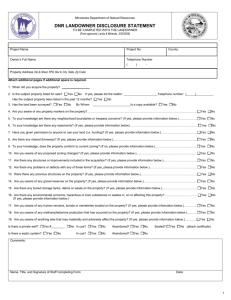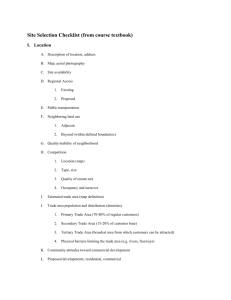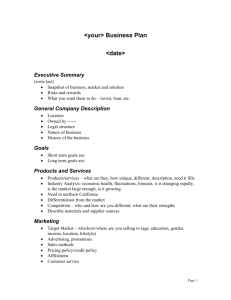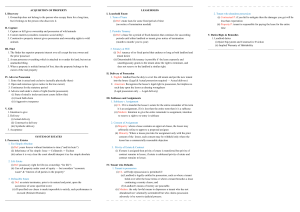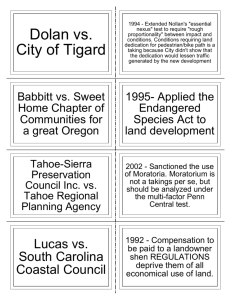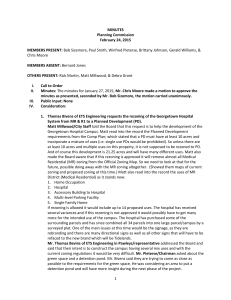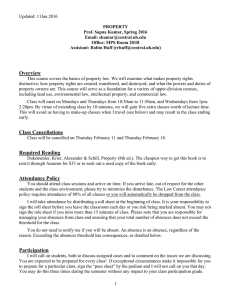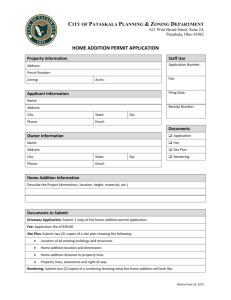Property Case Index
advertisement
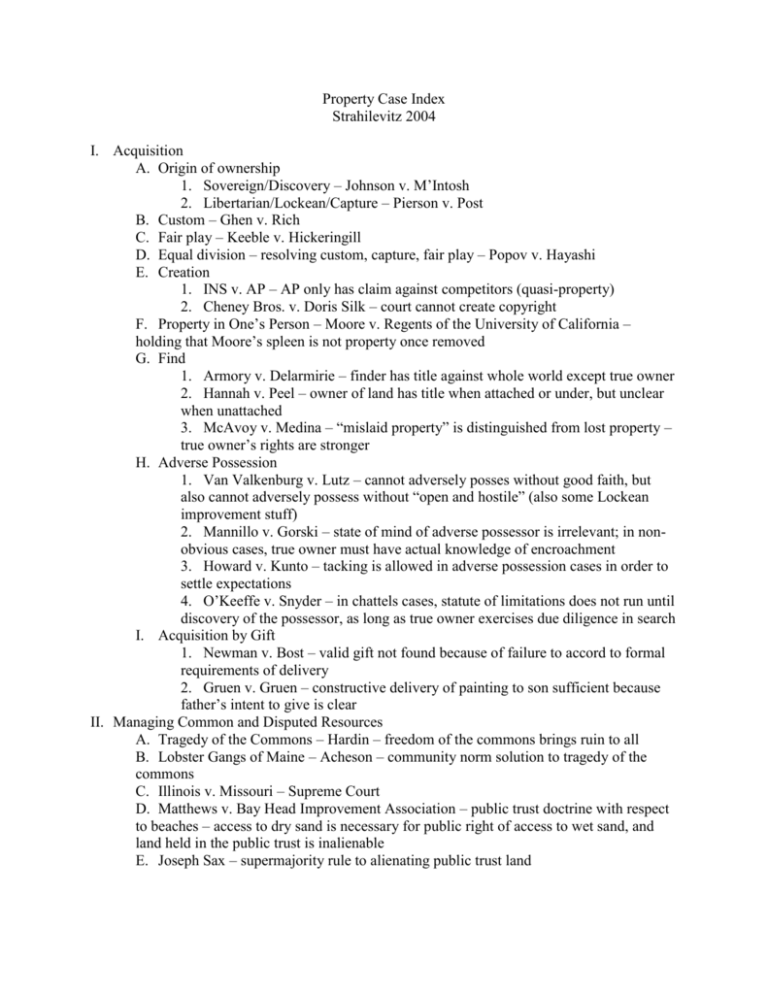
Property Case Index Strahilevitz 2004 I. Acquisition A. Origin of ownership 1. Sovereign/Discovery – Johnson v. M’Intosh 2. Libertarian/Lockean/Capture – Pierson v. Post B. Custom – Ghen v. Rich C. Fair play – Keeble v. Hickeringill D. Equal division – resolving custom, capture, fair play – Popov v. Hayashi E. Creation 1. INS v. AP – AP only has claim against competitors (quasi-property) 2. Cheney Bros. v. Doris Silk – court cannot create copyright F. Property in One’s Person – Moore v. Regents of the University of California – holding that Moore’s spleen is not property once removed G. Find 1. Armory v. Delarmirie – finder has title against whole world except true owner 2. Hannah v. Peel – owner of land has title when attached or under, but unclear when unattached 3. McAvoy v. Medina – “mislaid property” is distinguished from lost property – true owner’s rights are stronger H. Adverse Possession 1. Van Valkenburg v. Lutz – cannot adversely posses without good faith, but also cannot adversely possess without “open and hostile” (also some Lockean improvement stuff) 2. Mannillo v. Gorski – state of mind of adverse possessor is irrelevant; in nonobvious cases, true owner must have actual knowledge of encroachment 3. Howard v. Kunto – tacking is allowed in adverse possession cases in order to settle expectations 4. O’Keeffe v. Snyder – in chattels cases, statute of limitations does not run until discovery of the possessor, as long as true owner exercises due diligence in search I. Acquisition by Gift 1. Newman v. Bost – valid gift not found because of failure to accord to formal requirements of delivery 2. Gruen v. Gruen – constructive delivery of painting to son sufficient because father’s intent to give is clear II. Managing Common and Disputed Resources A. Tragedy of the Commons – Hardin – freedom of the commons brings ruin to all B. Lobster Gangs of Maine – Acheson – community norm solution to tragedy of the commons C. Illinois v. Missouri – Supreme Court D. Matthews v. Bay Head Improvement Association – public trust doctrine with respect to beaches – access to dry sand is necessary for public right of access to wet sand, and land held in the public trust is inalienable E. Joseph Sax – supermajority rule to alienating public trust land F. Coase – The Problem of Social Cost – in the absence of transaction costs, parties will always bargain to the efficient outcome G. Behavioral Law and Economics – bounded rationality, will power, self-interest H. Social Norms – Robert Ellickson – members of close-knit groups who are repeat players will develop a set of norms that enhances social welfare I. Schild v. Reuben – breakdown of norms of neighborliness in Encino, CA – litigation over basketball noise J. Ternant v. Boudreau – law defies social norm by stipulating that jewels buried in coffin are legal property of son K. Cravath, Swain, and Moore – successful common property regime versus Finley, Kumble – the unsuccessful one L. Pile v. Pedrick – use of a property rule for an encroaching factory wall that seems to result in a highly wasteful result M. Raab v. Casper – court could have used liability rule to structure remedy for half good-faith/half bad-faith encroaching cabin III. Nuisance Law A. Morgan v. High Penn Oil Co. – property right protection from an intentional, unreasonable nuisance B. Estancias Dallas Corp. v. Schultz – balancing of equities/costs must be taken into account in deciding a nuisance C. Boomer v. Atlantic Cement Co. – balancing of costs done explicitly, but only between parties to private dispute (supposedly) D. Spur Industries v. Del Webb Development Co. – liability rule for owner of feedlot – must move or shut down if Del Webb pays for costs E. Explaining Market Mechanisms – Thomas Merrill – market mechanisms for pollution control and why they are not used much yet IV. Ownership Interests A. Fee Simple and Life Estate 1. White v. Brown – can’t create a fee simple with restraint on alienation; presume that the testator will give away everything the testator owns if there is no clear evidence to the contrary (limit the ability for individuals to mix and match and create their own interests) 2. Baker v. Weedon – court will only force a sale if in the best interest of ALL parties with interests in a life estate, otherwise life tenant and remaindermen must agree B. Defeasible Estates 1. Marenholz v. County Board of School Trustees – can’t create a hybrid between fee simple determinable and fee simple subject to condition subsequent; illustrates how minor choice of words can have huge implications in the arena of future interests 2. Mountain Brow Lodge No. 82, Independent Order of Odd Fellows v. Toscano – direct restraint on alienation is always invalid, but restraint on use can be valid 3. Ink v. City of Canton – state condemns land given to city as a park, pays city money, court holds that the city must give the difference between fair market value of unrestricted land minus fair market value of park C. Rule Against Perpetuities 1. Jee v. Audley – no fee tail in personal property V. Rights of Ownership A. Right to Transfer 1. Stambovsky v. Ackley – caveat emptor lite – when there’s info that buyer couldn’t have found, and that seller created then the seller has to warn—this is a big exception 2. Brown v. Lober – failure to accurately describe that deed only gave 1/3 of mineral rights was not a breach of covenant of quiet enjoyment (constructive eviction) until someone with paramount title attempted to take possession of those rights B. Right to Exclude 1. Jacque v. Steenberg Homes, Inc. – individual right to exclude can trump efficiency, and punitive damages may be awarded to ensure right to exclude is not hollow 2. State v. Shack – social rights may sometimes trump individual property rights C. Right to Destroy 1. Eyerman v. Mercantile Trust Co. – right to destroy can be trumped if wasteful or there are other negative externalities VI. Multiple Owners and Users A. Concurrent Ownership 1. Harms v. Sprague – established the lien theory of mortgages in Illinois and determined that the mortgage on one joint tenant’s interest is extinguished at his death 2. Delfino v. Vealencis – partition in kind of a tenancy in common is preferable to partition by sale unless impractical and not in the best interests of both parties B. Marital Property 1. Sawada v. Endo – in Hawaii, a Group III state, a tenancy by entirety is not reachable by creditors of one spouse 2. United States v. 1500 Lincoln Ave. – 3rd Circuit case that says in criminal property seizure cases of tenancy by entirety, government can only reach survivorship interest of offending spouse C. Divorce 1. In re Marriage of Graham – in Colorado, an MBA does not count as property divisible after divorce 2. Elkus v. Elkus – in New York, status, reputation, earning power developed during marriage is divisible upon divorce 3. Mahoney v. Mahoney – in New Jersey, a halfway decision – we don’t want to divide earning power because it commodifies marriage, but we don’t want Graham behavior, so we compensate for one spouse’s sacrifice D. Landlord-Tenant Law 1. Garner v. Gerrish – abrogating New York’s common law rule assuming a tenancy at will where either party is given the power to terminate at will, and assuming a unilateral right (life estate determinable) if the contract unambiguously provides for it 2. Crechale & Polles, Inc. v. Smith – in Mississippi, can either evict or treat holdover as extension of lease, but not both 3. Hannan v. Dusch – landlord is obligated to put tenant in legal possession, but not physical possession 4. Berg v. Wiley – self-help is only permitted if peaceable, but the peaceable requirement stipulates the consent of the tenant, so basically, it’s never permitted (change from the common law rule that was a bit more permissive) 5. Hilder v. St. Peter – implied warranty of habitability in Vermont VII. Relations Among Neighbors A. Creating Easements 1. Willard v. First Church of Christ, Scientist – easements can be created in third parties B. Easements by Prescription and Necessity 1. Van Sandt v. Royster – creates standard for granting an easement by necessity, considering notice to parties, if parties contemplated continuing use in the transaction, did they have an opportunity to know about the use, if the easement is necessary as a practical matter 2. Othen v. Rosier – establishes formalist standard for determining if easement by prescription or necessity (none found by Texas SC) 3. Brown v. Voss – use of easement for benefit of more than one parcel is misuse, but only damages, no injunction C. Common Interest Communities 1. Nahrstedt v. Lakeside Village Condo Association, Inc. – condo regulations will be enforced unless unreasonable (great deference) VIII. Zoning A. Intro to Zoning 1. Euclid v. Ambler Realty Co. – zoning regulations are entitled to great deference and only struck down if fail the very loose rational relation test B. Flexibility/Pre-existing and Non-conforming Uses 1. PA Northwestern v. Zoning Hearing Board – if city zones out a lawful, previously conforming use, must pay compensation 2. State v. City of Rochester – court gives high degree of deference to city council’s decision to rezone a parcel to allow for high-density housing so long as there is a rational relationship to the overall zoning plan C. Aesthetics and Zoning 1. Stoyanoff v. Berkeley – aesthetic zoning is permissible, even though it may be vague 2. Anderson v. City of Issaquah – Washington court holds aesthetic zoning law void for vagueness 3. The differences between these two cases seem to turn on the facts D. Exclusionary Zoning 1. Southern Burlington NAACP v. Mount Laurel – cannot zone to exclude certain classes of people because the zoning power is delegated from the state and must be used to enhance welfare of the entire state IX. Takings A. Public Use and Just Compensation 1. Hawaii Housing Authority v. Midkiff – legislative scheme for breaking up land concentrations and redistributing land confers a public benefit so satisfies public use requirement 2. Poletown Neighborhood Council v. City of Detroit – condemning land for a GM plant is a public use because it preserves the tax base and provides jobs B. Categorical Takings 1. Loretto v. Teleprompter Manhattan CATV Corp. – any permanent physical occupation of land is a per se taking 2. Hadacheck v. Sebastian – laws banning a public nuisance are not a taking, even if a party’s property rights are substantially affected C. Chattels 1. Nixon v. United States – presidential papers are the personal property of the president, and must be compensated if there is a taking D. Regulatory Takings 1. Pennsylvania Mine Co. v. Mahon – landmark SC decision that finds a regulatory taking where a regulation substantially damages the value of property (“goes too far”) 2. Penn Central Transportation Company v. City of New York – establishes four-part standard for determining when a regulation “goes too far” 3. Lucas v. South Carolina Coastal Council – if a regulation destroys all economically beneficial or productive use of the land, it’s a taking, unless justified by background principles of state law 4. Tahoe-Sierra Preservation Council v. Tahoe Regional Planning Agency – time-limited interest does not constitute a total wipeout under Lucas, therefore no taking (pushes back on Lucas by implicitly rejecting conceptual severance) X. Intellectual Property A. Patents 1. Diamond v. Chakrabarty – patentable subject matter is very broad (everything made by man under the sun) 2. State Street Bank and Trust Co. v. Signature Financial Group, Inc. – business processes are patentable 3. Utility – Brenner v. Manson – process must produce a product that is useful to humans to be patentable (not really applied or used anymore) 4. Novelty – Rosaire v. National Lead Co. – if it was used by others and someone else was around to see it, potentially bars the patent 5. Novelty – In re Hall – even an obscure PhD dissertation in German in a library bars a patent 6. Nonobviousness – Graham v. John Deere – creates six-factor test for nonobviousness (synergy test now used for combination patents instead of Graham test) 7. Enablement – In re Strahilevitz – prophetic invention allowed as long as it will logically work given that each part works 8. Continental Paper Bag v. Eastern Paper Bag – patents are protected by a property rule and suppression is a valid use B. Copyright 1. Feist v. Rural Telephone Service – phonebook entries are facts, and not copyrightable 2. Baker v. Selden – delineates the boundary between copyright and patent law – explanation of a bookkeeping system is copyrightable, the system itself is not 3. Morissey v. Proctor and Gamble – merger doctrine 4. Ira Arnstein v. Cole Porter – creates three factor test for copyright infringement 5. Nichols v. Universal Pictures Corporation – alternate test for infringement, focusing on dissimilarities and similarities – concerned with underlying ideas 6. Anderson v. Stallone – unlicensed derivative works are wholly unprotected by copyright 7. Eldred v. Ashcroft – Congress is permitted to extend the copyright term for existing copyrighted works 8. Harper and Row v. Nation – use of quoted material from unpublished memoirs for magazine article is not fair use 9. Universal v. Sony – VCR record function is not contributory infringement as long as there are substantial, non-infringing uses
